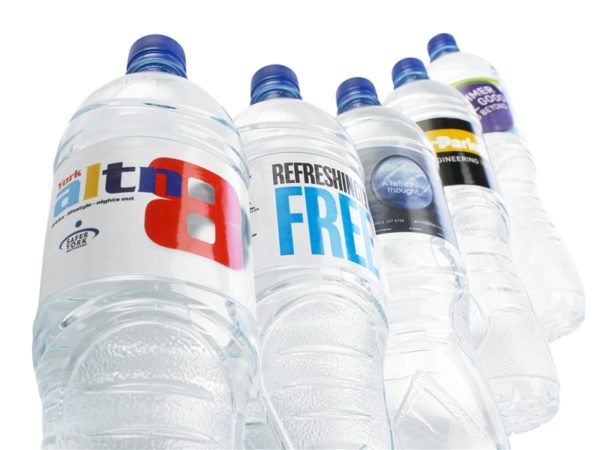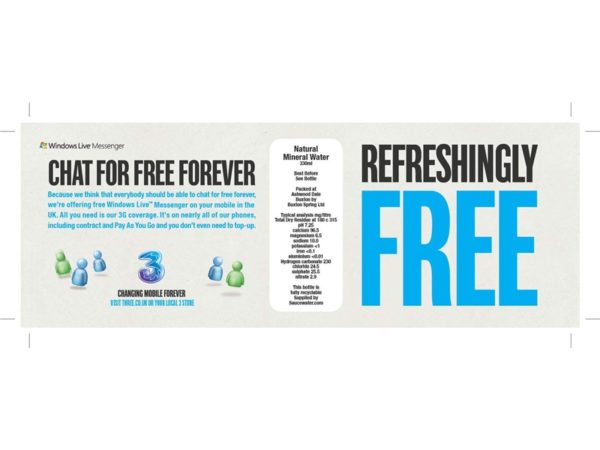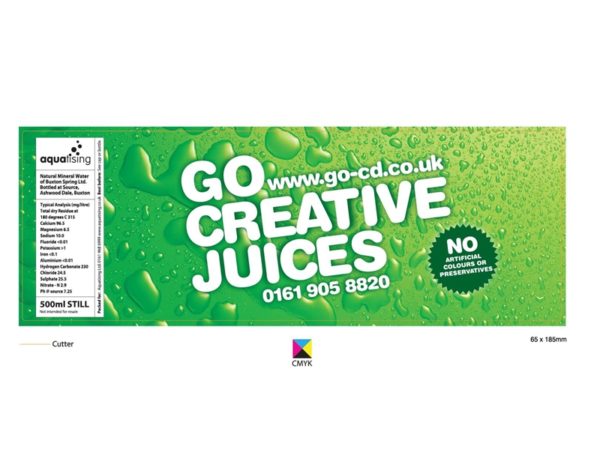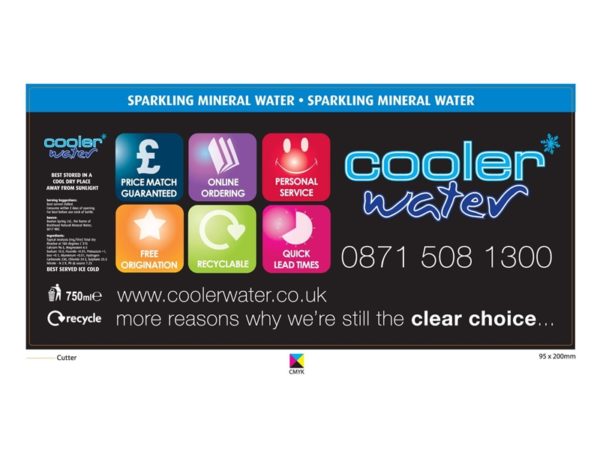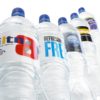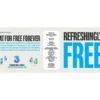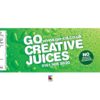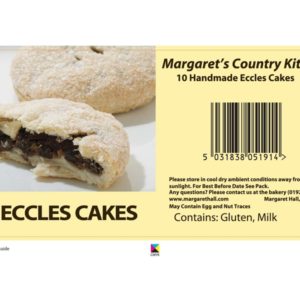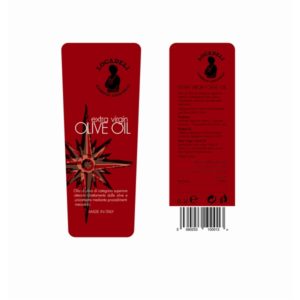Bottled Water Labels
Home / Full Product Range / Food and Drink Labels / Bottled Water Labels
Labelservice has many years of experience in working with promotions and marketing agencies, as well as the bottling plants themselves. Working closely with the material manufactuers, our labels are suitable for high speed automatic application, with adhesives suitable for storage in ambient or chilled conditions. Digital printing offer you the option of competitively producing short run, multi sort work with zero origination costs, whilst flexographic presses can cater for full production runs.
Please contact us for free samples or a printed proof from your artwork.
Water Bottle Labels FAQs
Labelservice has many years of experience in working with promotions and marketing agencies, as well as the bottling plants themselves.
Water bottle labels are used for raising brand awareness at charity events, fun-runs, and sports events. In a corporate setting, these labels are ideal for business meetings, conventions, and conferences. They can also be included in promotional gift baskets to make a lasting impression on clients or partners.
Beyond business applications, personalised water bottle labels offer a unique touch for personal events. Whether it’s a wedding, birthday, or christening, customising the label design with names or dates adds a special element to the occasion.
For a 250ml (25cl) Water Bottle: The label size is approximately 4.92″ x 1.42″ (125mm x 36mm). This size is available in the template section during the order process.
For a 500ml (50cl) Water Bottle: The label size is roughly 7.68″ x 1.97″ (195mm x 50mm). This size can also be selected from the template section during the order process.
For a 1.5L Water Bottle: The label size is about 10.83″ x 2.36″ (275mm x 60mm). This size is available as a custom option.
The glue that affixes water bottle labels is specially engineered to withstand a variety of conditions, making it a vital component in the labelling process. These water-based adhesives are designed for high-efficiency labelling, capable of adhering to a range of challenging materials. They work seamlessly with all standard labelling machinery and are particularly well-suited for paper-based labels. With the ability to maintain performance at extremely high speeds, these adhesives also offer resistance to water condensation and freezing conditions.
When it comes to adhesive strength, options range from highly permanent to easily removable, depending on the material you choose for your labels. It’s worth noting that removable, low-tack adhesives are not advised for use on plastic bottles. As for the labels themselves, they can be digitally printed in superior quality CMYK on various substrates. These include waterproof vinyl in either a matte or glossy finish, as well as adhesive paper available in uncoated, glossy, or brown kraft finishes.
First, ensure the bottle surface is clean and dry. Peel the backing off the label and carefully align it with the bottle. Starting from one end, press the label onto the surface and smooth it out to eliminate any air bubbles or wrinkles. For best results, use a squeegee or flat edge to secure the label firmly. Once applied, allow some time for the adhesive to set for maximum durability.
The choice of material for water bottle labels depends on the application and durability needs. Standard paper is commonly used for retail or promotional labels, particularly when the bottles are intended for single use. For situations requiring greater durability, waterproof vinyl is a favoured option.
In cases where the labels need to be especially resistant to moisture, plastic films such as polyester, polypropylene, and biaxially oriented polypropylene (BOPP) are often used. These materials are well-suited for both glass and plastic bottles and offer enhanced moisture resistance, making them ideal for liquid-containing bottles
The waterproof quality of water bottle labels largely depends on the material used. Standard paper labels are generally not waterproof and are best suited for single-use applications where moisture resistance is not a priority. However, for situations requiring labels to withstand moisture, such as refrigeration or outdoor events, waterproof materials like vinyl are recommended.
Plastic films like polyester, polypropylene, and biaxially oriented polypropylene (BOPP) are also excellent choices for water-resistant labels. These materials are not only resistant to moisture but also offer durability
He recyclability of water bottle labels varies based on the material. If a label is made from the same type of recyclable plastic as the container, both can be recycled together. However, if the label is made from paper or a different type of recyclable plastic, it can contaminate the recycling process for the container. For those seeking an eco-friendly option, our cut labels with recycled paper are an ideal solution.
For retail and promotional purposes, standard single-use plastic bottles are often used.
For more premium or specialty products, glass bottles are frequently chosen for their upscale appearance and perceived quality. Reusable plastic bottles made from materials like Tritan™ or stainless steel containers are also becoming increasingly popular for their eco-friendly appeal
In corporate settings, you may find water bottle labels on larger, multi-use dispensers or jugs. These are typically made from more durable materials like polycarbonate or high-density polyethylene (HDPE).
Labelservice has many years of experience in working with promotions and marketing agencies, as well as the bottling plants themselves. Working closely with the material manufactuers, our labels are suitable for high speed automatic application, with adhesives suitable for storage in ambient or chilled conditions. Digital printing offer you the option of competitively producing short run, multi sort work with zero origination costs, whilst flexographic presses can cater for full production runs.
Please contact us for free samples or a printed proof from your artwork.
Water Bottle Labels FAQs
Labelservice has many years of experience in working with promotions and marketing agencies, as well as the bottling plants themselves.
Water bottle labels are used for raising brand awareness at charity events, fun-runs, and sports events. In a corporate setting, these labels are ideal for business meetings, conventions, and conferences. They can also be included in promotional gift baskets to make a lasting impression on clients or partners.
Beyond business applications, personalised water bottle labels offer a unique touch for personal events. Whether it’s a wedding, birthday, or christening, customising the label design with names or dates adds a special element to the occasion.
For a 250ml (25cl) Water Bottle: The label size is approximately 4.92″ x 1.42″ (125mm x 36mm). This size is available in the template section during the order process.
For a 500ml (50cl) Water Bottle: The label size is roughly 7.68″ x 1.97″ (195mm x 50mm). This size can also be selected from the template section during the order process.
For a 1.5L Water Bottle: The label size is about 10.83″ x 2.36″ (275mm x 60mm). This size is available as a custom option.
The glue that affixes water bottle labels is specially engineered to withstand a variety of conditions, making it a vital component in the labelling process. These water-based adhesives are designed for high-efficiency labelling, capable of adhering to a range of challenging materials. They work seamlessly with all standard labelling machinery and are particularly well-suited for paper-based labels. With the ability to maintain performance at extremely high speeds, these adhesives also offer resistance to water condensation and freezing conditions.
When it comes to adhesive strength, options range from highly permanent to easily removable, depending on the material you choose for your labels. It’s worth noting that removable, low-tack adhesives are not advised for use on plastic bottles. As for the labels themselves, they can be digitally printed in superior quality CMYK on various substrates. These include waterproof vinyl in either a matte or glossy finish, as well as adhesive paper available in uncoated, glossy, or brown kraft finishes.
First, ensure the bottle surface is clean and dry. Peel the backing off the label and carefully align it with the bottle. Starting from one end, press the label onto the surface and smooth it out to eliminate any air bubbles or wrinkles. For best results, use a squeegee or flat edge to secure the label firmly. Once applied, allow some time for the adhesive to set for maximum durability.
The choice of material for water bottle labels depends on the application and durability needs. Standard paper is commonly used for retail or promotional labels, particularly when the bottles are intended for single use. For situations requiring greater durability, waterproof vinyl is a favoured option.
In cases where the labels need to be especially resistant to moisture, plastic films such as polyester, polypropylene, and biaxially oriented polypropylene (BOPP) are often used. These materials are well-suited for both glass and plastic bottles and offer enhanced moisture resistance, making them ideal for liquid-containing bottles
The waterproof quality of water bottle labels largely depends on the material used. Standard paper labels are generally not waterproof and are best suited for single-use applications where moisture resistance is not a priority. However, for situations requiring labels to withstand moisture, such as refrigeration or outdoor events, waterproof materials like vinyl are recommended.
Plastic films like polyester, polypropylene, and biaxially oriented polypropylene (BOPP) are also excellent choices for water-resistant labels. These materials are not only resistant to moisture but also offer durability
He recyclability of water bottle labels varies based on the material. If a label is made from the same type of recyclable plastic as the container, both can be recycled together. However, if the label is made from paper or a different type of recyclable plastic, it can contaminate the recycling process for the container. For those seeking an eco-friendly option, our cut labels with recycled paper are an ideal solution.
For retail and promotional purposes, standard single-use plastic bottles are often used.
For more premium or specialty products, glass bottles are frequently chosen for their upscale appearance and perceived quality. Reusable plastic bottles made from materials like Tritan™ or stainless steel containers are also becoming increasingly popular for their eco-friendly appeal
In corporate settings, you may find water bottle labels on larger, multi-use dispensers or jugs. These are typically made from more durable materials like polycarbonate or high-density polyethylene (HDPE).


